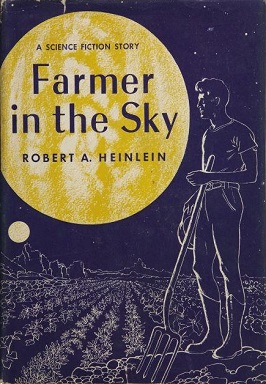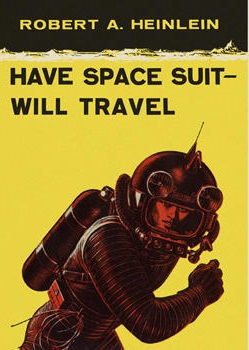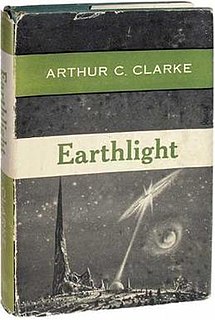Related Research Articles

Double Star is a science fiction novel by American writer Robert A. Heinlein, first serialized in Astounding Science Fiction and published in hardcover the same year. It received the 1956 Hugo Award for Best Novel.

Citizen of the Galaxy is a science fiction novel by American writer Robert A. Heinlein, originally serialized in Astounding Science Fiction and published in hardcover in 1957 as one of the Heinlein juveniles by Scribner's. The story is heavily influenced by Rudyard Kipling's Kim.

The Moon Is a Harsh Mistress is a 1966 science fiction novel by American writer Robert A. Heinlein about a lunar colony's revolt against absentee rule from Earth. The novel expresses and discusses libertarian ideals. It is respected for its credible presentation of a comprehensively imagined future human society on both the Earth and the Moon. Originally serialized monthly in Worlds of If, the book was nominated for the Nebula Award in 1966 and received the Hugo Award for Best Novel in 1967.

Methuselah's Children is a science fiction novel by American writer Robert A. Heinlein. Originally serialized in Astounding Science Fiction in the July, August, and September 1941 issues, it was expanded into a full-length novel in 1958.

Farmer In The Sky is a 1950 science fiction novel by American writer Robert A. Heinlein about a teenaged boy who emigrates with his family to Jupiter's moon Ganymede, which is in the process of being terraformed. Among Heinlein's juveniles, a condensed version of the novel was published in serial form in Boys' Life magazine, under the title "Satellite Scout". The novel was awarded a Retro Hugo in 2001.

Have Space Suit—Will Travel is a science-fiction novel for young readers by American writer Robert A. Heinlein, originally serialised in The Magazine of Fantasy & Science Fiction and published by Scribner's in hardcover in 1958. The last of the Heinlein juveniles, it was nominated for a Hugo Award in 1959 and won the Sequoyah Children's Book Award for 1961. Heinlein's engineering expertise enabled him to add realistic detail; during World War II, he had been a civilian aeronautics engineer at a laboratory which developed pressure suits for use at high altitudes.

The Rolling Stones is a 1952 science fiction novel by American writer Robert A. Heinlein.

The Past Through Tomorrow is a collection of science fiction stories by American writer Robert A. Heinlein, all part of his Future History.

Earthlight is a science fiction novel by British writer Arthur C. Clarke, published in 1955. It is an expansion to novel length of a novella of the same name that he had published four years earlier.

A Fall of Moondust is a hard science fiction novel by British writer Arthur C. Clarke, first published in 1961. It was nominated for a Hugo Award for Best Novel, and was the first science fiction novel selected to become a Reader's Digest Condensed Book.
The Moon has been the subject of many works of art and literature and the inspiration for numerous others. It is a motif in the visual arts, the performing arts, poetry, prose, and music.

Subterranean fiction is a subgenre of adventure fiction, science fiction, or fantasy which focuses on fictional underground settings, sometimes at the center of the Earth or otherwise deep below the surface. The genre is based on, and has in turn influenced, the Hollow Earth theory. The earliest works in the genre were Enlightenment-era philosophical or allegorical works, in which the underground setting was often largely incidental. In the late 19th century, however, more pseudoscientific or proto-science-fictional motifs gained prevalence. Common themes have included a depiction of the underground world as more primitive than the surface, either culturally, technologically or biologically, or in some combination thereof. The former cases usually see the setting used as a venue for sword-and-sorcery fiction, while the latter often features cryptids or creatures extinct on the surface, such as dinosaurs or archaic humans. A less frequent theme has the underground world much more technologically advanced than the surface one, typically either as the refugium of a lost civilization, or as a secret base for space aliens.
"Goldfish Bowl" is a science fiction short story by American author Robert A. Heinlein, first published in Astounding Science Fiction in March 1942, and collected in one of Heinlein's anthologies, The Menace from Earth.

"The Year of the Jackpot" is a science fiction short story by American writer Robert A. Heinlein, first published 1952, and collected in one of Heinlein's anthologies, The Menace from Earth.
The science fiction writer Robert A. Heinlein (1907–1988) was productive during a writing career that spanned the last 49 years of his life; the Robert A. Heinlein bibliography includes 32 novels, 59 short stories and 16 collections published during his life. Four films, two TV series, several episodes of a radio series, and a board game derive more or less directly from his work. He wrote a screenplay for one of the films. Heinlein edited an anthology of other writers' SF short stories.
"Destination Moon" is a novella by science fiction author Robert A. Heinlein, first published in the September 1950 issue of Short Stories magazine; it is an adaptation of Heinlein's own screenplay for the 1950 feature film Destination Moon.

Jupiter's extensive system of natural satellites – in particular the four large Galilean moons – has been a common science fiction setting.
The works known as Heinlein juveniles are the young-adult novels written by Robert A. Heinlein. Scribner's published the twelve novels between 1947 and 1958; together they tell a single story of space exploration. A thirteenth work, Starship Troopers, was submitted to Scribner's but rejected and instead published by Putnam. A fourteenth novel, Podkayne of Mars, is often listed as a "Heinlein juvenile", although Heinlein himself did not consider it to be one.

The Menace From Earth is a collection of science fiction short stories by American writer Robert A. Heinlein. It was published by The Gnome Press in 1959 in an edition of 5,000 copies.

The Domes of Pico is a juvenile science fiction novel, the second in Hugh Walters' Chris Godfrey of U.N.E.X.A. series. It was published in the UK by Faber in 1958, in the US by Criterion Books in 1959 under the title Menace from the Moon and in the Netherlands by Prisma Juniores as 'De Maan Valt Aan' in 1960.
References
- ↑ Gale, Floyd C. (December 1960). "Galaxy's 5 Star Shelf". Galaxy Science Fiction. pp. 123–127.